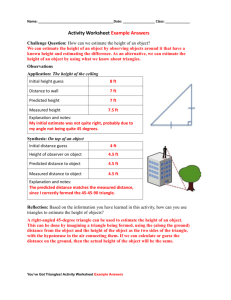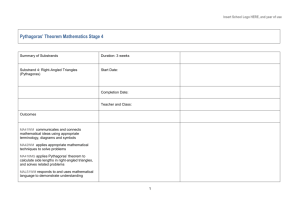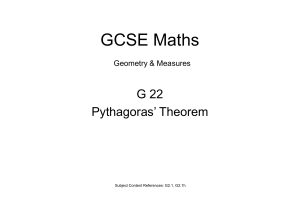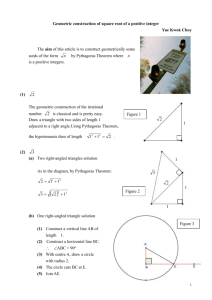DOC - MathsGeeks
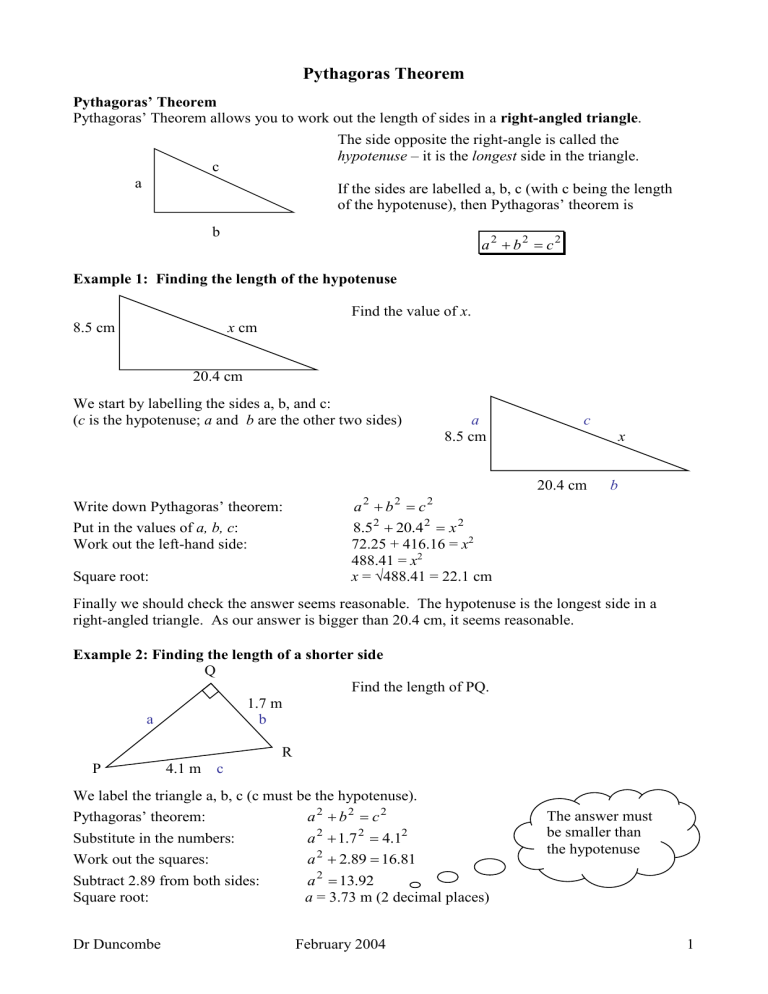
Pythagoras Theorem
Pythagoras’ Theorem
Pythagoras’ Theorem allows you to work out the length of sides in a right-angled triangle .
The side opposite the right-angle is called the hypotenuse – it is the longest side in the triangle.
a c
If the sides are labelled a, b, c (with c being the length of the hypotenuse), then Pythagoras’ theorem is b a
2 b
2 c
2
Example 1: Finding the length of the hypotenuse
8.5 cm x cm
Find the value of x .
20.4 cm
We start by labelling the sides a, b, and c:
( c is the hypotenuse; a and b are the other two sides) a
8.5 cm c x
20.4 cm b
Write down Pythagoras’ theorem: a
2 b
2 c
2
Put in the values of
Work out the left-hand side:
Square root: a, b, c : 8 .
5
2
20 .
4
2 x
2
72.25 + 416.16 = x
2
488.41 = x
2 x = √488.41 = 22.1 cm
Finally we should check the answer seems reasonable. The hypotenuse is the longest side in a right-angled triangle. As our answer is bigger than 20.4 cm, it seems reasonable.
Example 2: Finding the length of a shorter side
Find the length of PQ. a
Q
1.7 m b
R
P 4.1 m c
We label the triangle a, b, c (c must be the hypotenuse).
Pythagoras’ theorem:
Substitute in the numbers:
Work out the squares:
Subtract 2.89 from both sides:
Square root: a
2 b
2 a
2
1 .
7
2
c
2
4 .
1
2 a
2
2 .
89
16 .
81 a
2
13 .
92 a = 3.73 m (2 decimal places)
The answer must be smaller than the hypotenuse
Dr Duncombe February 2004 1
Examination Question 1:
The diagram shows the position of a ferry sailing between Folkestone and Calais.
X 24km
The ferry is at X.
The position of the ferry from Calais is given as:
North of Calais 15km,
15 km
West of Calais 24km.
Calculate the distance of the ferry from Calais.
Calais
Give your answer to one decimal place.
Examination Question 2
F
26 cm
G 24 cm H
In the diagram, triangle FGH is right-angled at G.
GH = 24cm and FH = 26 cm.
Calculate the length of FG.
Pythagoras’ Theorem in Isosceles Triangles
An isosceles triangle can be split into 2 right-angled triangles:
It is therefore possible to use Pythagoras theorem to find lengths in isosceles triangles.
Example:
Find the area of this triangle.
9cm
6cm
Split the triangle into two:
4.5 cm
We can find the height of the triangle: h
2
4 .
5
2
6
2 h
2 h
2
20 .
25
36
15 .
75
Therefore the area is …
1
2
b
h
1
2
9
3 .
97
17 .
9 cm
2 h 6 cm
So… h = 3.97 cm
Dr Duncombe February 2004 2
Examination Question 3
B
19.5 m
D A A
16.4 m
C
19.5 m
AB = 19.5 cm, AC = 19.5 cm and BC = 16.4 cm.
Angle ADB = 90˚.
BDC is a straight line.
Calculate the length of AD. Give your answer in centimetres , correct to 1 decimal place.
Note: Pythagoras’ theorem could occur on the non-calculator paper.
Example for non-calculator paper
4cm x
Find the value of x.
5 cm
Pythagoras’ theorem: a
2
4
2
b
2
5
2
16
25
c
2 x
2 x
2
41
x
2
So, x = √41 cm
Since you do not have a calculator, leave the answer as a square root. Do not try to estimate the square root of 41 unless you are told to do so.
Example 2: Non-calculator paper
√20 cm
√11cm x cm
Pythagoras’ theorem:
So,
Find the value of x . a
2
b
2
2
x c
2
2
2
11
x
2
20 x
2
9 x = 3 cm
Note that
2
11
Dr Duncombe February 2004 3
Application of Pythagoras’ Theorem: Finding the distance between two points
Example : The coordinates of the points A and B are (6, 8) and (1, 1). Work out the length of AB.
Sketch A sketch showing the positions of points A and B is an important first step.
B(1,1) 5 units
A(6, 8)
7 units a
2
7
2
b
2
5
2
c c
2
2
49
25
74 = c 2
c
2
So the length AB is… √74 = 8.6 units
Other uses of Pythagoras’ Theorem
Example
24 cm
25 cm
7cm
Prove that the triangle is right-angled.
Solution
Pythagoras’ theorem only works in right-angled triangles, so we need to show that the triangle above satisfies Pythagoras’ theorem.
The longest side is 25 cm so this would have to be the hypotenuse, c . The two shortest sides, a and b , are 7 cm and 24 cm.
Pythagoras:
Left-hand side: a
2 b
2 a
2 b
2
c
2
7
2
24
2
625
Right-hand side: c
2
25
2
625
So the right-hand side is equal to the left-hand side, so Pythagoras works in this triangle.
Therefore the triangle is right-angled.
Special triangles - right-angled triangles with whole number sides
The triangle at the top of this page is special as it is a right-angled triangle that has sides which are all whole numbers. Two other common right-angled triangles with sides that are whole numbers are:
3cm 5cm
This is called the 3, 4, 5 triangle
5cm
13 cm
4cm
12 cm
Dr Duncombe February 2004 4
You can use these basic triangles to get other right-angled triangles by multiplying all the sides by the same number. For example, a triangle with lengths 6cm, 8cm and 10cm would be right-angled
(as its sides are double those in the 3, 4, 5 triangle).
Right-angled triangles in semi-circles
A
C B
Look at the triangle shown here.
If AB is a diameter
ACB has a
of the circle, then triangle right-angle at C (this is one of the circle theorems – an angle in a semi-circle is
90 degrees).
Example
The side AB is the diameter of a circle. Find the length marked a . Give your answer to 1 decimal place.
C
A
12cm
16cm a
B
Solution
As AB is a diameter of a circle, angle ACB is a right angle. Therefore the hypotenuse is 16 cm.
Pythagoras: a
2 b
2 c
2
12
2 a
2
16
2
144
a
2 a
2
256
256
144
112 a = √112 = 10.6 cm (to 1 dp)
Further examination question
A
10m
B
5m
C
8m
D
Find length AB. Give your answer correct to 3 significant figures.
(Hint: You will need to find length BD first, using the lower triangle).
Dr Duncombe February 2004 5


